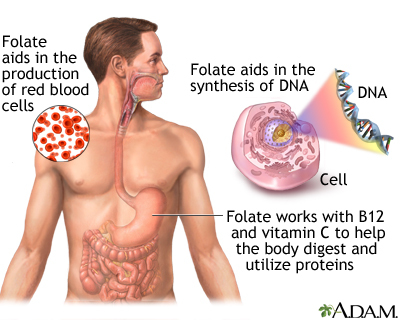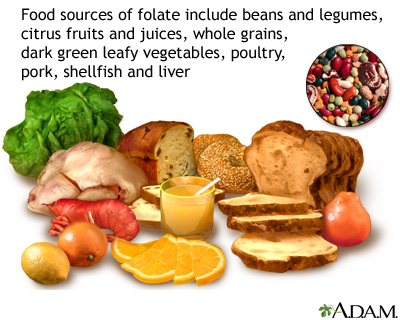The Food that Fuels You
Many people use the start of the new year as a reminder to get back into their diet and exercise routine, but it’s important that we maintain these healthy…

Update your location to show providers, locations, and services closest to you.
Folic acid and folate are both terms for a type of B vitamin (vitamin B9).
Folate is a B vitamin that occurs naturally in foods such as green leafy vegetables, citrus fruit, and beans.
Folic acid is man-made (synthetic) folate. It is found in supplements and added to fortified foods.
The terms folic acid and folate are often used interchangeably.
Folic acid is water-soluble. Leftover amounts of the vitamin leave the body through the urine. That means your body does not store folic acid. You need to get a regular supply of the vitamin through the foods you eat or through supplements.
Folic acid; Polyglutamyl folacin; Pteroylmonoglutamate; Folate
Folate has many functions in the body:
Folate deficiency may cause:
It may also lead to certain types of anemias.
Because it's hard to get enough folate through foods, women thinking about becoming pregnant need to take folic acid supplements. Taking the right amount of folic acid before and during pregnancy helps prevent neural tube defects, including spina bifida. Taking higher doses of folic acid before you get pregnant and during the first trimester may lower your chances of miscarriage.
Folic acid supplements may also be used to treat a lack of folate, and may help with some kinds of menstrual problems and leg ulcers.
Folate occurs naturally in the following foods:
Fortified means that vitamins have been added to the food. Many foods are now fortified with folic acid. Some of these are:
There are also many pregnancy-specific products on the market that have been fortified with folic acid. Some of these are at levels that meet or exceed the RDA for folate. Women should be careful about including a high amount of these products in their diets along with their prenatal multivitamin. Taking more is not needed and does not provide any added benefit.
The tolerable upper intake level for folic acid is 1000 micrograms (mcg) a day. This limit is based on folic acid that comes from supplements and fortified foods. It does not refer to the folate found naturally in foods.
Folic acid does not cause harm when used at recommended levels. Folic acid dissolves in water. This means that it is regularly removed from the body through urine, so excess amounts do not build up in the body.
You should not get more than 1000 mcg per day of folic acid. Using higher levels of folic acid can mask vitamin B12 deficiency.
The best way to get the daily requirement of essential vitamins is to eat a wide variety of foods. Most people in the United States get enough folic acid in their diet because there is plenty of it in the food supply.
Folic acid can help reduce the risk for certain birth defects, such as spina bifida and anencephaly.
The Recommended Dietary Allowance (RDA) for vitamins reflects how much of each vitamin most people should get each day.
The Food and Nutrition Board of the National Academies of Sciences, Engineering, and Medicine Recommended Intakes for Individuals - Daily Reference Intakes (DRIs) for folate:
Infants
*For infants from birth to 12 months, the Food and Nutrition Board established an Acceptable Intake (AI) for folate that is equivalent to the mean intake of folate in healthy, breastfed infants in the United States.
Children
Adolescents and adults


Bodnar LM, Himes KP. Maternal nutrition. In: Resnik R, Lockwood CJ, Moore TR, Greene MF, Copel JA, Silver RM, eds. Creasy and Resnik's Maternal-Fetal Medicine: Principles and Practice. 8th ed. Philadelphia, PA: Elsevier; 2019:chap 12.
Institute of Medicine (US) Standing Committee on the Scientific Evaluation of Dietary Reference Intakes and its Panel on Folate, Other B Vitamins, and Choline. Dietary reference intakes for thiamin, riboflavin, niacin, vitamin B6, folate, vitamin B12, pantothenic acid, biotin, and choline. National Academies Press. Washington, DC, 1998. PMID: 23193625 www.ncbi.nlm.nih.gov/pubmed/23193625/.
Mason JB, Booth SL. Vitamins, trace minerals, and other micronutrients. In: Goldman L, Schafer AI, eds. Goldman-Cecil Medicine. 26th ed. Philadelphia, PA: Elsevier; 2020:chap 205.
Markell M, Siddiqi HA. Vitamins and trace elements. In: McPherson RA, Pincus MR, eds. Henry's Clinical Diagnosis and Management by Laboratory Methods. 24th ed. St Louis, MO: Elsevier; 2022:chap 27.
Ramu A, Neild P. Diet and nutrition. In: Naish J, Syndercombe Court D, eds. Medical Sciences. 3rd ed. Philadelphia, PA: Elsevier; 2019:chap 16.
Many people use the start of the new year as a reminder to get back into their diet and exercise routine, but it’s important that we maintain these healthy…
